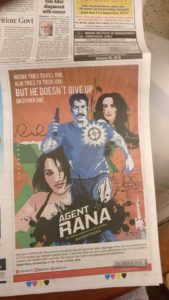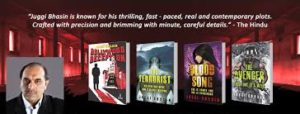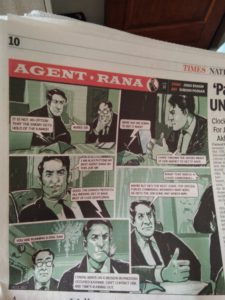Guest Post: Juggi Bhasin “Different roads, one destination”
Juggi Bhasin is a successful writer who ” living out fulfilling a lifelong ambition: to become a writer”. Earlier this month he began serialising a graphic novel in the popular national daily, Times of India. Recognising this as a new and innovative experiement in creative storytelling I requested Juggi Bhasin to contribute a blog post on what it means to experiment in form, is there any difference to his storytelling etc. Here is his lovely note. Read on.
Late at night when I climb into bed, I set the alarm to wake me up, sharp at seven, next morning. It is that time of the  day when I get up to sip some green tea, chew a couple of almonds and review in The Times of India, my graphic novel and daily feature, ‘Agent Rana’.
day when I get up to sip some green tea, chew a couple of almonds and review in The Times of India, my graphic novel and daily feature, ‘Agent Rana’.
It’s a good time for me to review not just the novel but my entire journey through various art forms to reach that one common goal. And that goal is undoubtedly the production and dissemination of creative content that gives pleasure to my readers and me.
Every writer in a sense has had a long journey whether in years or in the mind. My journey began as a TV journalist and in my mind’s eye I can still see myself as the only Indian TV journalist that went to North Korea to meet old man Kim, the father of the present infamous dictator running that unfortunate country. Or that morning of Dec 6th, 1992, when I stood at the Babri Masjid with my TV crew and watched and recorded the structure being razed to the ground. I wanted to write a book about those earth shaking experiences but I did not have the words or the syntax or even the drive then to express my thoughts and emotions. The only weapon I had then at my command was what is popularly called in journalese —a ‘good copy’ ability. Many journalists write good copy but it does not make them into great writers. I had a good eye though, an active imagination and a great visual sense.
In the years after the events of Babri Masjid, I worked on stage, in serials and a couple of films and developed my visual imagination and sharpened my emotional outreach. The words to match my visuals also came to me and became a part of my development. By 2012, I felt I was ready to strike out as a writer. The passion in me to write something was overbearing and I felt I had developed a syntax which in a sense was a very different life form from ‘good copy.’
It resulted in my first book The Terrorist which was a national bestseller. The unusual element in The Terrorist was not only its theme but its usage of highly, evocative, visual imagery almost as if the reader was looking at breathtaking visuals from an Akira Kurosawa war film. The combination of intense passion and a visualised style of writing became the key notes of my writing. Many found it unusual, far removed from the traditional ‘bookish’ qualities, whatever they might be, that they felt a book should have. But it were my real life dramatic experiences of news reporting in Kashmir, insurgency hit areas and forbidden lands helped me to sculpt an intense, visually enriching writing style. My visualised writing style compels me to open a window in the reader’s mind. It is the gateway to explore the imagination; which is a desired goal for any author. My successive three novels after the The Terrorist incorporate this style which now has become an article of faith for me.
So when I was asked to write a graphic novel for the Times of India, a commission no one has ever done before in this country, it struck me that it would flow all so naturally for me. I had to produce text that was economic in its choice of words and length. It would have to write a text which supported powerful visuals but was also evocative and stirring. This is what Agent Rana accomplishes day after day in the Times of India.
This brings me to my thesis that all art forms are interconnected to create a single, living organism that pulsates with life and passion. The end goal is to explore the human condition. I, believe, that there is no such thing as a purist style of writing. All creative output is the result of myriad experiences, both stylistic and cerebral. In December, this year, my fifth book, Fear is the Key which has a female protagonist, will be released by Penguin Random House. It is perhaps my most challenging work to date. It is a psychological thriller and tells the story of a man conflicted in his mind.
So, that then is the challenge for me. How do you show the conflicts of the mind as evocative imagery? Writing for different genres is like a seven course meal; each course releasing different flavours at the tip of your tongue. But it all leads to that simple but profound thought at the end of it. ‘I really enjoyed myself. It was a great meal.’
Different roads, one destination. There is really no contradiction in that!
© Juggi Bhasin
18 September 2017


